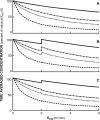Contribution of residual function to removal of protein-bound solutes in hemodialysis
- PMID: 21030575
- PMCID: PMC3052218
- DOI: 10.2215/CJN.06100710
Contribution of residual function to removal of protein-bound solutes in hemodialysis
Abstract
Background and objectives: This study evaluated the contribution of residual function to the removal of solutes for which protein binding limits clearance by hemdialysis.
Design, setting, participants, & measurements: Solute concentrations were measured in 25 hemodialysis patients with residual urea clearances ranging from 0.1 to 6.2 ml/min per 1.73 m2. Mathematical modeling assessed the effect of residual function on time-averaged solute concentrations.
Results: Dialytic clearances of the protein-bound solutes p-cresol sulfate, indoxyl sulfate, and hippurate were reduced in proportion to the avidity of binding and averaged 8±2, 10±3, and 44±13% of the dialytic urea clearance. For each bound solute, the residual clearance was larger in relation to the residual urea clearance. Residual kidney function therefore removed a larger portion of each of the bound solutes than of urea. Increasing residual function was associated with lower plasma levels of p-cresol sulfate and hippurate but not indoxyl sulfate. Wide variation in solute generation tended to obscure the dependence of plasma solute levels on residual function. Mathematical modeling that corrected for this variation indicated that increasing residual function will reduce the plasma level of each of the bound solutes more than the plasma level of urea.
Conclusions: In comparison to urea, solutes than bind to plasma proteins can be more effectively cleared by residual function than by hemodialysis. Levels of such solutes will be lower in patients with residual function than in patients without residual function even if the dialysis dose is reduced based on measurement of residual urea clearance in accord with current guidelines.
Figures



Similar articles
-
Residual Function Effectively Controls Plasma Concentrations of Secreted Solutes in Patients on Twice Weekly Hemodialysis.J Am Soc Nephrol. 2018 Jul;29(7):1992-1999. doi: 10.1681/ASN.2018010081. Epub 2018 May 4. J Am Soc Nephrol. 2018. PMID: 29728422 Free PMC article.
-
Removal of the protein-bound solutes indican and p-cresol sulfate by peritoneal dialysis.Clin J Am Soc Nephrol. 2008 Jan;3(1):85-90. doi: 10.2215/CJN.02570607. Epub 2007 Nov 28. Clin J Am Soc Nephrol. 2008. PMID: 18045861 Free PMC article. Clinical Trial.
-
Effect of increasing dialyzer mass transfer area coefficient and dialysate flow on clearance of protein-bound solutes: a pilot crossover trial.Am J Kidney Dis. 2009 Jun;53(6):1042-9. doi: 10.1053/j.ajkd.2009.01.265. Epub 2009 Apr 25. Am J Kidney Dis. 2009. PMID: 19394728 Free PMC article.
-
The removal of protein-bound solutes by dialysis.J Ren Nutr. 2012 Jan;22(1):203-6. doi: 10.1053/j.jrn.2011.10.011. J Ren Nutr. 2012. PMID: 22200443 Review.
-
An update on uremic toxins.Int Urol Nephrol. 2013 Feb;45(1):139-50. doi: 10.1007/s11255-012-0258-1. Epub 2012 Aug 15. Int Urol Nephrol. 2013. PMID: 22893494 Review.
Cited by
-
Incremental hemodialysis, a valuable option for the frail elderly patient.J Nephrol. 2019 Oct;32(5):741-750. doi: 10.1007/s40620-019-00611-4. Epub 2019 Apr 19. J Nephrol. 2019. PMID: 31004284 Review.
-
Time-averaged concentration estimation of uraemic toxins with different removal kinetics: a novel approach based on intradialytic spent dialysate measurements.Clin Kidney J. 2022 Dec 20;16(4):735-744. doi: 10.1093/ckj/sfac273. eCollection 2023 Apr. Clin Kidney J. 2022. PMID: 37007697 Free PMC article.
-
The Dual Roles of Protein-Bound Solutes as Toxins and Signaling Molecules in Uremia.Toxins (Basel). 2022 Jun 11;14(6):402. doi: 10.3390/toxins14060402. Toxins (Basel). 2022. PMID: 35737063 Free PMC article. Review.
-
Narrative Review of Incremental Hemodialysis.Kidney Int Rep. 2019 Dec 6;5(2):135-148. doi: 10.1016/j.ekir.2019.11.014. eCollection 2020 Feb. Kidney Int Rep. 2019. PMID: 32043027 Free PMC article. Review.
-
The Microbiome and Uremic Solutes.Toxins (Basel). 2022 Mar 30;14(4):245. doi: 10.3390/toxins14040245. Toxins (Basel). 2022. PMID: 35448854 Free PMC article. Review.
References
-
- Paniagua R, Amato D, Vonesh E, Correa-Rotter R, Ramos A, Moran J, Mujais S: Effects of increased peritoneal clearances on mortality rates in peritoneal dialysis: ADEMEX, a prospective, randomized, controlled trial. J Am Soc Nephrol 13: 1307–1320, 2002 - PubMed
-
- Bargman JM, Thorpe KE, Churchill DN: Relative contribution of residual renal function and peritoneal clearance to adequacy of dialysis: A reanalysis of the CANUSA study. J Am Soc Nephrol 12: 2158–2162, 2001 - PubMed
-
- Krediet RT: How to preserve residual renal function in patients with chronic kidney disease and on dialysis? Nephrol Dial Transplant 21[Suppl 2]: ii42–ii46, 2006 - PubMed
-
- Ng TG, Johnson DW, Hawley CM: Is it time to revisit residual renal function in haemodialysis? Nephrology (Carlton) 12: 209–217, 2007 - PubMed
-
- Termorshuizen F, Dekker FW, van Manen JG, Korevaar JC, Boeschoten EW, Krediet RT: Relative contribution of residual renal function and different measures of adequacy to survival in hemodialysis patients: An analysis of the Netherlands Cooperative Study on the Adequacy of Dialysis (NECOSAD)-2. J Am Soc Nephrol, 15: 1061–1070, 2004 - PubMed
Publication types
MeSH terms
Substances
Grants and funding
LinkOut - more resources
Full Text Sources
Medical

